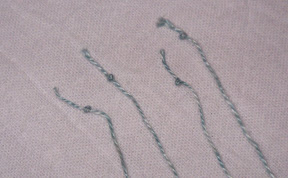Stitch Study: Waffle Stitch (or Norwich Stitch) Tutorial
Yes, after an almost-two-year hiatus, I’m actually writing a stitch study post again. This is my first stitch study on a canvaswork stitch, the waffle stitch.
A bit about naming
Before getting into the details about the stitch, it helps to discuss the naming of this stitch. Like many stitches, this one comes up in stitch books under multiple names. In this case, it can be either the waffle stitch or the Norwich stitch.
The reverse is also true, though. The name “waffle stitch” is also another name for the broad cross stitch, and there are waffle stitches in both knitting and crochet.
Don’t be intimidated…
When first encountering the waffle stitch, it’s easy to be overwhelmed. Depending on the type of stitch diagram and the size of the waffle stitch, the numbering on the diagram can quickly reach double digits. By breaking the stitch down and explaining the pattern, though, I’m hoping you’ll find it more approachable and perhaps even relaxing to stitch.
Let’s get started!

The next stitch starts a repetitive pattern. To provide a bit of contrast and because it looks more interesting, I switched to a different color.




There! That’s one round, or one repeat, of the stitch.
Step 6. Repeat steps 2-5, moving one hole closer to the center of each side with each round. So the second round will start by traveling (on the back) up the left side, and coming up one thread below the previous round.

With another round complete, you’ll have something that looks like this:

Keep going, repeating steps 2 through 5, changing colors as desired.
Here’s why some folks say you have to start with an odd number of threads. I’d like to add one more round of stitches, but if you look closely at the picture above, you’ll see I only have one open hole on each side. I can’t stitch another round like the previous rounds.
So I have to cheat. This round just isn’t going to have stitches on the back along the edges of the square. Oh well. Who’s going to know?
Step 7. Here’s how I like to stitch the last round on an even waffle stitch. I use double running stitch!
Yes, the back isn’t quite as orderly…
…but who cares?
So what about odd waffles?
When you do have an odd number of threads in your waffle, you can just stitch the normal rounds right up to the end. Here’s the beginning of the last round of the waffle if it’s stitched over 13 threads.
A side-by-side comparison
Front: Back:
About ending threads
You may be wondering why I left all of the thread ends off to the side. In this case, it was for demonstration purposes. When I’m using waffles in a project, I’ll sometimes bury the ends in surrounding stitches. Usually, though, I’ll use L stitches to start and end threads in the middle of the waffle, since they’ll be covered over anyway.
Now it’s your turn
Are you ready to tackle waffle stitches? Try them out and let me know how it goes! What are your favorite threads to use? (By the way, ribbons, like Kreinik’s 1/16” metallic ribbon or Rainbow Gallery’s Neon Rays, work wonderfully.) What color combinations do you like? What’s the biggest waffle you’ve tried?
Please share! (And let me know if anything isn’t clear above!)











































